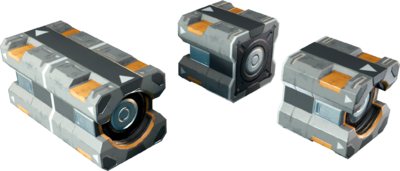Difference between revisions of "Network relay"
Jump to navigation
Jump to search
m (de added as flag.) |
m (→Device fields) |
||
| Line 34: | Line 34: | ||
! description | ! description | ||
! range | ! range | ||
|- | |||
! '''IsMasterEnabled''' | |||
| On / Off | |||
| 0 / 1 | |||
|- | |- | ||
! '''IsEnabled''' | ! '''IsEnabled''' | ||
| On / Off | | On / Off, read only | ||
| 0 / 1 | | 0 / 1 | ||
|} | |} | ||
[[Category:Devices and machines|Network relay]] | [[Category:Devices and machines|Network relay]] | ||
Revision as of 12:39, 10 July 2020
Summary

The network relay is a device used to separate a network within a ship or station into multiple partially separate sub-networks.
Separate sub-networks allow one-way broadcasting of variable changes between them, and enable the creation of modular YOLOL systems.
Basic information
- Network Relays are connected to two separate data networks via cable sockets at both ends of the device
- One end of the relay acts as the "input" connection
- The other end acts as the "output" connection
- When the relay is powered, changes made to device fields connected to the input propagate will apply to all similarly named device fields that are connected to relay output
- Values between networks are not automatically synchronized
- This means that connected networks may contain different values for similarly named device fields
- Values between networks are not automatically synchronized
Device fields
To learn more about how to use fields, consult these wiki pages:
| YOLOL field | description | range |
|---|---|---|
| IsMasterEnabled | On / Off | 0 / 1 |
| IsEnabled | On / Off, read only | 0 / 1 |